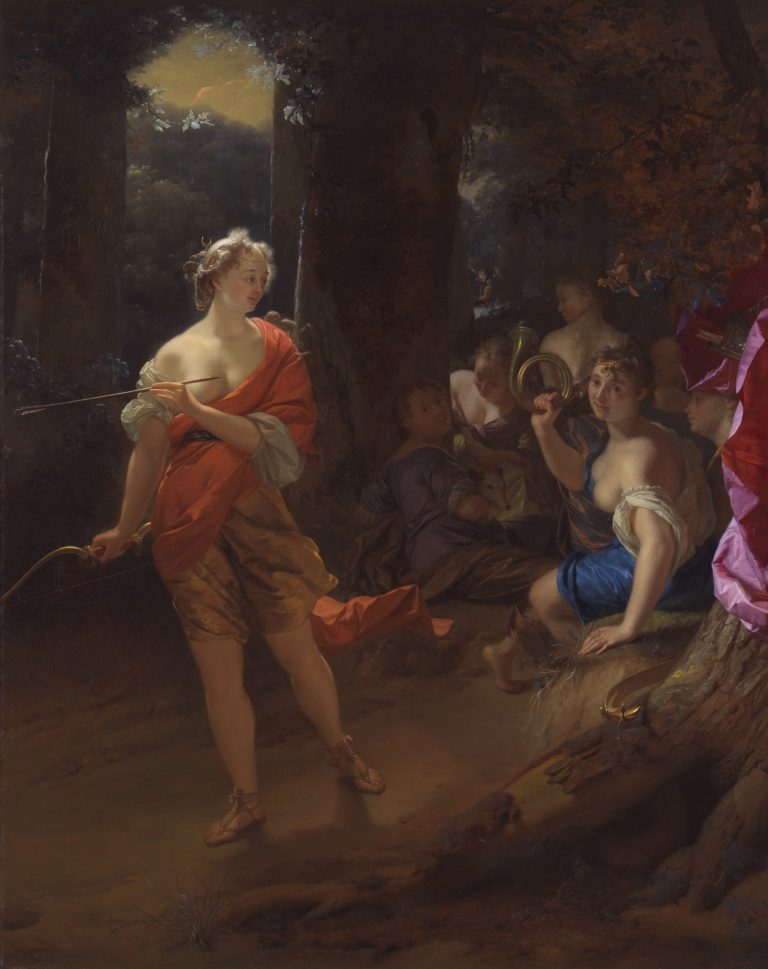The goddess Diana, recognizable by the crescent moon in her beautifully pinned-up hair, is portrayed in wooded surroundings. Dressed in a short gown, as described by Ovid in the Metamorphoses, she holds a bloody arrow in her left hand and a bow in her right hand. Diana’s companions—six nymphs—have sat down to rest after having tended to her hunting horn, quiver, cloak and one of the hounds; several other nymphs can be seen behind the trees in the background. This scene refers to Ovid’s narrative:
Here the goddess of the wild woods, when weary with the chase, was wont to bathe her maiden limbs in the crystal water. On this day, having come to the grotto, she gives to the keeping of her armor-bearer among her nymphs her hunting spear, her quiver, and her unstrung bow; another takes on her arm the robe she has laid by; two unbind her sandals from her feet. But Theban Crocale, defter than the rest, binds into a knot the locks which have fallen down her mistress’s neck, her own locks streaming free the while (book 3, lines 162–70).1
Godefridus Schalcken certainly knew his Ovid.2 His father, Cornelius Schalckius (1610/11–74), a doctor of theology, was rector of the Latin School in Dordrecht, which explains why he is known by the Latinized form of his name (Cornelis Schalcken). Godefridus attended his father’s school, and was initially trained—as were his brothers Balthasar (1637–79) and Johannes (1660–1724)—to study theology, for which extensive knowledge of Latin was essential. Godefridus, however, struck out on his own path. In the words of Houbraken, his contemporary and fellow townsman, “his love of art made him bid farewell to the study of languages, even though he was far advanced in them.”3
Diana and Her Nymphs in a Clearing also exists in two other versions, both of which are on panel. The best known version is to be found in the collection of the Counts of Schönborn at Schloss Weißenstein in Pommersfelden (fig 1), where it has been documented since 1729.4 The second version was last seen at a sale at Sotheby’s in London in 1993. Beherman prefers this latter version to the one in Pommersfelden, probably for good reason, because it is now clear that it once belonged to the renowned eighteenth-century collections of Jan Bisschop (1680–1771) in Rotterdam and John Hope (1737–84) in Amsterdam.5
The three versions are nearly identical: apart from the support, they differ only in size. The version discussed here is on canvas and measures 82.6 x 66.4 cm, whereas the dimensions of the panel in Pommersfelden are 83 x 62 cm, and the work seen at the 1993 sale in London measured 84 x 66.5 cm. Despite the lack of a signature on all these versions, there is no reason to doubt Schalcken’s authorship. It is striking, however, that the master repeated this evidently successful composition more than once, so it is not unreasonable to assume that his pupils contributed significantly to one or more versions.
In general, versions on panel would have been preferred over those on canvas, because wooden supports were more expensive than linen. This rule, however, does not always apply to the work of Schalcken. We know, for example, that in 1690 he painted the portrait of Maria Anna of Pfalz-Neuburg (1667–1740), the sister of the Elector in Düsseldorf, on canvas, whereas the version produced by studio assistants is on panel.6 Because the three versions of Diana and Her Nymphs in a Clearing are so close in quality, only firsthand comparison of all three works would enable one to determine which is Schalcken’s autograph version and to what extent the replicas were produced by studio assistants.
Beherman dated the versions he knew to around 1680–85, which, in my opinion, is too early. The palette—with its pleasant, light colors verging in some cases on pastel shades—and the long, elegant figure of Diana indicate that all three versions must have originated later, sometime between about 1685 and 1692, the year Schalcken moved to London. In that period Schalcken had a number of his best pupils working in his studio: Arnold Boonen (1669–1729),7 who was in any case active in the studio from 1 December 1685 to 3 December 1687; Richard Morris (1670–89),8 who is documented on 1 December 1685 as Schalcken’s pupil; and Justus van Bentum (1670–1727), whom we know only from listings in old catalogues, where he is mentioned as a pupil of Schalcken.9 In view of Boonen’s and Morris’s success in approaching their teacher’s manner, it certainly should come as no surprise that Schalcken managed, with the help of these three assistants, to produce three paintings of equally high quality.
Schalcken’s subject of choice from sacred history was evidently Mary Magdalene, but the goddess Diana was his favorite theme from ancient history and mythology. His earliest Diana dates from around 1680, when he portrayed Magdalena de la Court (1661–1712) at approximately 18 years of age as the goddess of the hunt. He depicted her without a crescent moon adorning her hair, but with a bow and arrow hunting in a wooded landscape.10 In the mid-1680s Schalcken used the genre of the portrait historié more frequently, when portraying, for example, several other young women as Diana and Two Companions, a painting for which a preparatory drawing survives.11 This portrayal and the somewhat earlier Goddess Diana Out Hunting in a Wood, which some are also inclined to see as a portrait historié,12 served as the examples for the three depictions of Diana and Her Nymphs in a Clearing, whose most important pictorial elements can be traced to those two works.
